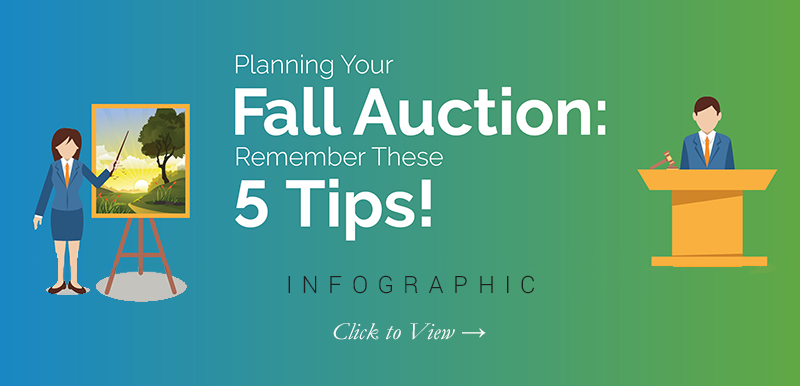Fall event fundraising season is well underway, and end-of-year events like #GivingTuesday are around the corner. Needless to say—you have a lot on your plate!
If you’re hosting an auction, you don’t want to miss any key details. This might mean auditioning multiple auctioneers until you find the right fit; purchasing software to help ensure the event runs smoothly; securing last-minute event sponsorships from local businesses and more.
To help, our friends at BidPal have put together a 5 step “auction cheat sheet” that shows everything that needs to get done at a glance, preventing auction challenges before they ever become mission critical. Plus, each step is conveniently separated into silent, live and online auctions so you can tailor to your event.
Finally, we’ve curated the best Winspire News resources for each of these steps, providing the expertise and time-saving templates you need to turn these tips into reality. (You’ll want to hit Ctrl + D and bookmark today’s post!)
Let’s take a closer look at each of these 5 steps.
1. Employ the help of auction software.
Is auction software right for my event?
In today’s tech world, technology like auction software and mobile bidding are becoming more and more popular. And it’s no doubt that technology, when used right, makes planning and executing charity auctions easier for nonprofits.
We are frequently asked if the benefits of auction technology are worth the cost. The answer depends on how committed your organization is to utilizing the tools at your disposal.
The most immediately helpful features of auction software make administrative tasks more efficient, such as online ticketing, mobile bidding in a silent auction and the creation of branded event websites.
Another bonus is the ability to track auction results for more targeted procurement efforts in the future.

Auction software helps you determine which items actually made money and which weren’t worth the effort. By tracking every aspect of your event, you have more than anecdotal evidence to determine what’s successful and what can be improved.
For more, check out these helpful articles:
- Mobile and Online Bidding: A Comprehensive Guide to Silent Auction Technology
- Can Auction Software Help My Fundraiser Make More Money?
2. Put items front and center.
Do my donors consider our silent auction a luxury shopping spree?
You’ve worked hard for months to procure great items. Now you only have a few hours to get as much revenue from these offerings as possible. Your bidders are sophisticated buyers, and their first impression with the items is most likely their last. So, looks definitely matter.
First, put items front and center. Keep the most valuable items at eye level, and be sure there’s plenty of space to examine the items.
For spacing tips, check out the following:
- 3 Tips for Displaying Auction Items to Attract Fierce Bidding
- Silent Auction Spacing: What to Do When You Run out of Room
You’ll also want sleek item displays that highlight the best features of the items. This is especially important for items that cannot be physically presented, such as a trip on the Napa Valley Wine Train or dinner at a gourmet restaurant.
Since graphic designers can be costly, consider making your own professional displays with our free, 100% customizable templates below.
{{cta(‘f82a5467-7b49-46ae-9e35-96b6d29291a8′,’justifycenter’)}}
3. Use an auction checklist.
It’s an all too common feeling as you step in to the room on event night: I feel like we’re forgetting something…what is it?!
The auction elements noted in the infographic—a good sound system, auctioneer, your items themselves and more—are indeed bare-bone essentials. However, we couldn’t fit everything you need for a successful night into one graphic! (Just imagine starting your silent auction without pens on the tables.)
To help, we highly recommend checking out Winspire’s latest resource, Checklist Builder. It’s free to sign up and create an account, giving you instant access to 4 of the 14 event committees. You can delegate tasks, check off tasks as they’re completed and get time-saving resources and related templates.
{{cta(‘ba326600-0d41-427d-9835-342fbadae3ec’,’justifycenter’)}}
If you like what you see, upgrade to the full annual subscription and unlock all committees (including the all-important ‘Silent & Live Auction Committee‘) for just $99.
4. Strategize the auction order.
In a live auction, the sequence in which you order your items matters.
You want to capitalize on momentum, capture second and third highest bidders, and create a smooth shopping experience for all participating bidders.
Do you know how to order your live auction items to garner the highest bids?
The simplest and most effective way to lay out your live auction: Draw a bell curve. Check out the Winspire News article below to discover how this sequence keeps the audience engaged and entertained—plus extracts higher bids.
{{cta(‘2493c44f-abf9-49d3-8678-cf7059e8567b’,’justifycenter’)}}
5. Maximize profits with other fundraising techniques.
It takes many different hooks to get many different fish.
Your event guests have diverse interests, backgrounds and income levels. You want to put out plenty of different ways people can support your cause at the event, also known as revenue generators or income streams.
Make the most of all your hard work by incorporating different income streams throughout the night. Here’s a list of resources you can use to implement each of the ideas mentioned in the infographic.
- Hold a raffle: “Raise $10,000 with a ‘Winner’s Choice’ Fundraising Raffle“
- Set up a donation booth: “Fundraising Incentives: 8 Top Strategies to Sweeten Giving“
- Charge an admission price: “13 Proven Ways to Revive a Stagnant Fundraising Event“
- Make a live appeal: “Fund-a-Need 101: 4 Steps to Execute a Smooth Cash Appeal“
- Offer no-risk travel Experiences: “Why Travel Budgets Are Awesome for Your Fundraising Bottom Line“
- Seek out corporate sponsors: “10 Easy Steps to Effective Sponsorship Request Letters [FREE TEMPLATES]“
Of course these 6 ideas are just scratching the surface of what’s possible. For even MORE ideas, stay tuned to Winspire News! (If your colleagues haven’t subscribed, direct them to this page to subscribe, plus earn another entry in our Donation Give-away.) We are always developing new resources to make your events even more lucrative.
{{cta(‘1a1cf4d1-a3b1-4e4c-8687-8512e667053f’,’justifycenter’)}}


